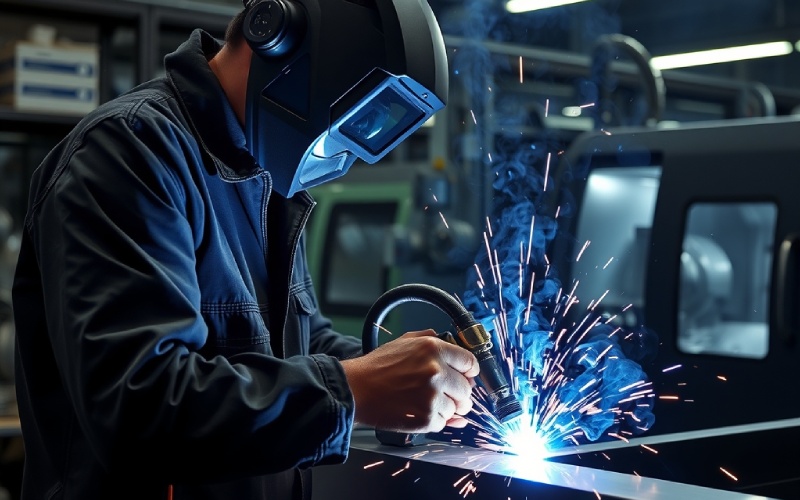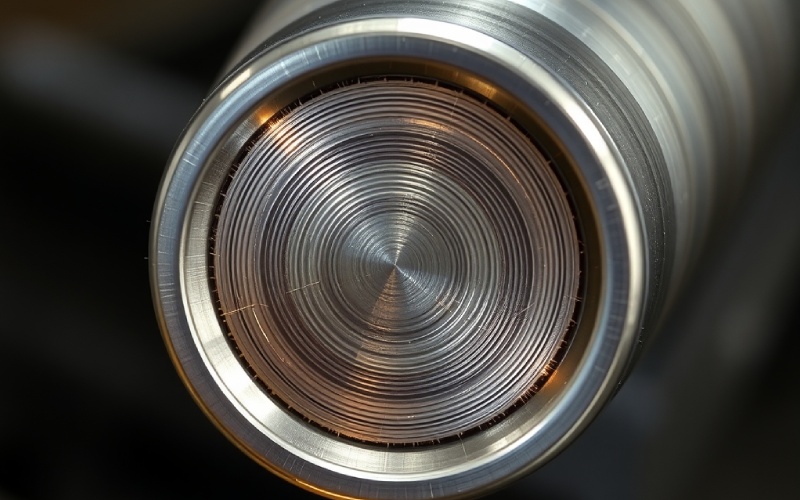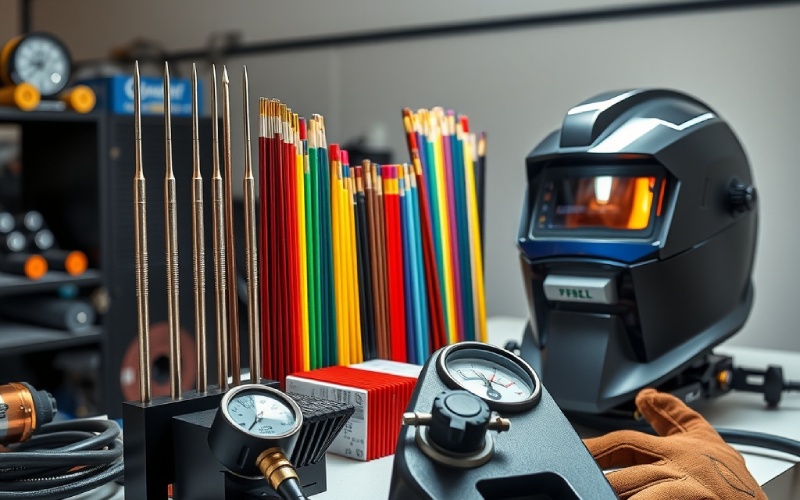Deje que Istar le ayude a poner en marcha su proyecto con nuestra experiencia y conocimientos.
Cargue sus archivos de diseño y requisitos de producción y nos pondremos en contacto con usted en menos de 30 minutos.

The TIG weld has always been special because it is very exact and makes clean-looking joints. TIG welding is also known by its technical name, Gas Tungsten Arc Welding (GTAW). This process gives a welder a great deal of control. It helps create strong welds that also look very good. This article is for you if you want to know why TIG welding is the top choice for important jobs in the aerospace and car industries. It is also for new welders who want to learn about this useful and satisfying skill.
From my experience, the easiest way to learn about something is to look at its basic parts. To make a TIG weld, you use a non-consumable tungsten electrode. This electrode heats up the metal you are working with. The term ‘non-consumable’ means the electrode does not melt. It does not become a part of the finished weld. This is different from MIG welding, where the electrode does melt. The TIG welding process starts when you create an electric arc. This arc forms between the sharp tungsten electrode and the piece of metal.
This arc is very hot, reaching temperatures as high as 11,000°F. The heat melts the base metals. This creates a small puddle of liquid metal called a weld pool. When this pool cools and hardens, it forms a strong connection. The liquid metal needs to be protected from the air around it. If air touches the liquid metal, it can cause problems and make the weld weak. To stop this, a shielding gas flows out of the TIG torch. This is why the name includes ‘Inert Gas.’ The gas, which is usually argon, forms a protective shield around the area you are welding. Sometimes you need a stronger weld, or you need to build up the joint. In these cases, you use your other hand to add a separate filler metal rod into the liquid weld pool. This technique of using two hands is why TIG welding is known for being so exact and easy to control. The entire process gets its power from a welding machine that supplies a steady electric current.
People often ask me why they should pick TIG welding. They point out that other welding processes, like MIG welding or shielded metal arc welding, are often faster. The simple answer is control. A skilled welder can control the heat and the filler metal separately. This allows them to make very exact and clean welds. This makes TIG welding a great choice for projects where looks matter. For example, it’s used for making metal art or special car parts. The process creates almost no messy splatter. This means you will spend less time cleaning up after you are done welding.
TIG welding can also be used in many different ways. You can use it to weld more types of metals than with other methods. These metals include aluminum, stainless steel, magnesium, copper, and titanium. This makes it a very useful skill for anyone who works with different kinds of materials. For example, when welding stainless steel, TIG welding gives you a clean, top-quality finish. This is often needed in industries that make food, drinks, or medical tools. Other welding methods might be cheaper for thick pieces of metal. But TIG welding is the better choice for thin metals. Its low heat keeps the metal from bending or burning through.
Let me show you the basic steps for making a TIG weld. Before you even start the arc, getting ready is the most important part. You must make sure your metal is clean. It needs to be free of oil, rust, or paint. A clean surface is very important for making a strong TIG weld that has no defects. The process of TIG welding needs you to have a steady hand and to pay close attention.
After your welding machine is set up the right way, hold the TIG torch in one hand. Keep it at about a 75-degree angle to the piece of metal. The tungsten electrode should be held about 1/16 to 1/8 of an inch from the metal surface. Next, you start the arc. You can do this with a high-frequency start or a lift arc method. These create the first spark without the tungsten electrode needing to touch the metal. When the arc forms, a pool of melted metal will show up on the base metal. Then, you will move the TIG torch along the line you want to weld. You need to keep the distance of the arc and your speed the same. If you are using a filler metal, use your other hand to dip the filler rod into the front part of the melted pool. This requires good coordination. It is a key part of the TIG welding technique.
The tungsten electrode is the most important part of the TIG welding process. It is a non-consumable electrode. This means it is not supposed to melt and become part of the weld. Its job is to bring the welding current to the arc. The kind of tungsten electrode you should use changes based on the metal you are welding. It also depends on whether you are using AC or DC power. Different kinds of tungsten electrodes have different colors so you can easily tell them apart.
| Tungsten Electrode Type | Color Code | Uso principal |
|---|---|---|
| Pure Tungsten | Verde | AC welding of aluminum and magnesium. |
| 2% Thoriated | Rojo | DC welding of steel and stainless steel. |
| 2% Ceriated | Grey | Low-amperage DC welding. |
| 2% Lanthanated | Azul | Versatile for both AC and DC welding. |
| Zirconiated | White | AC welding, particularly for aluminum. |
It is also very important to sharpen your tungsten electrode correctly. This helps you get a steady arc and a good quality TIG weld. For DC welding, you usually grind the tungsten so it has a sharp point. For AC welding, it is better to have a tip that is rounded like a ball. A dirty tungsten electrode will cause problems. This can happen if the electrode touches the liquid weld pool or the filler rod. A dirty electrode creates an unstable arc and a bad TIG weld.

To begin TIG welding, you will need several important pieces of welding equipment. The main part of the TIG welding system is the power source. This is also called the welding machine. New TIG welders have many controls that let you adjust the welding process very carefully. You will also need a TIG torch. The torch holds the tungsten electrode and sends out the shielding gas. Torches can be air-cooled for jobs that use less power. They can also be water-cooled for bigger, more demanding jobs.
You must have a tank of shielding gas, which is usually argon. You also need a regulator and a hose to control the gas flow and protect the weld. You will also need a ground clamp. This completes the electrical path. A foot pedal or a remote control on the torch lets the welder manage the welding current. This is an important feature of the TIG process because it allows for very exact heat control. Last, you will need a variety of tungsten electrodes. And, if the job needs them, you will also need filler metal rods. And, of course, do not forget your safety gear. This includes a welding helmet.
Picking the correct shielding gas is a very important part of setting up for a TIG weld. The shielding gas keeps the liquid weld pool and the hot tungsten electrode safe from the air. Without this protection, the air would dirty the weld and ruin it. The most common shielding gas for TIG welding is pure argon. It can be used in many different situations. It works well for welding many kinds of metals, like aluminum and stainless steel. It also helps create a steady arc and helps clean the metal.
In some cases, a mix of different gases is used. If you add helium to the argon, you can make the weld hotter and go deeper. This is helpful when welding thicker materials. It is also good for metals that transfer heat well, like copper and aluminum. A mix of argon and helium is also used to help you weld faster. When you weld some kinds of stainless steel, you might add a little hydrogen or nitrogen to the argon. This can make the finished TIG weld better. But, it is very important to use the right gas for the specific metal and job. If you don’t, you might have problems like cracks or the metal might rust more easily. For most normal TIG welding jobs, using 100% argon is a safe and good choice.
Because a TIG weld is so exact and high-quality, it is a process used in many different industries. One of the most common uses for TIG welding is in the aerospace industry. In this field, the strength of welds on airplanes and spaceships must be perfect. TIG welding is used to connect tubes with thin walls. It is also used to build parts from aluminum, titanium, and other very strong alloys.
The car industry also uses TIG welding a lot. It is especially used for making custom parts, doing repair work, and welding exhaust systems and frames. You will also see TIG welding used a lot to make equipment for food and drinks and for medical tools. It’s even used to create art sculptures where a clean, nice-looking finish is the most important thing. Since TIG welding works well on many metals, like aluminum and stainless steel, it is used for many different things. This welding method is also perfect for welding the first layer, or root pass, inside pipes. This makes sure the joint is strong and does not leak.
I will be honest with you. TIG welding is usually seen as the hardest welding process to learn well. It needs a lot of coordination. The welder has to use one hand to move the TIG torch. They must keep the arc length and their speed steady. At the same time, they must use their other hand to add the filler metal into the liquid weld pool. In addition to that, many TIG welding machines have a foot pedal that controls the power. This makes the process even more complicated.
But, do not let that stop you from trying. It is harder to learn than MIG welding. But, the benefits of getting good at TIG welding are very big. The best way to learn TIG welding is to practice a lot. I suggest you start with thicker steel, about 2mm or 3mm thick. This is because the liquid weld pool will be bigger and easier for you to control. When you first start, just try making weld lines without adding a filler rod. This will help you get used to controlling the TIG torch and the liquid metal. If you practice over time and stay committed, anyone can learn the skills they need to make excellent TIG welds.

Even welders with a lot of experience have problems sometimes. Here are some of the common problems I have seen in TIG welding and how you can fix them:
Safety should always be the most important thing when you are doing any kind of welding. This is also true for TIG welding. The arc from TIG welding gives off strong ultraviolet (UV) light. This light can give you a bad sunburn and hurt your eyes. You must always wear a proper welding helmet. Make sure it has the right darkness level, or shade, to protect your eyes and face.
You also need to protect your skin from the UV light. You also need protection from sparks and hot pieces of metal. You should wear clothing that does not catch fire easily, like a leather welding jacket. You should also wear thick leather gloves. It is also very important to have good airflow. This will stop you from breathing in the fumes and gases that welding creates. Make sure the area where you work is clean. Make sure there is nothing that can easily catch fire nearby. Lastly, always check that your welding machine and the metal piece are correctly grounded. This helps to stop you from getting an electrical shock. Check your equipment often for any signs of damage before you start to TIG weld.